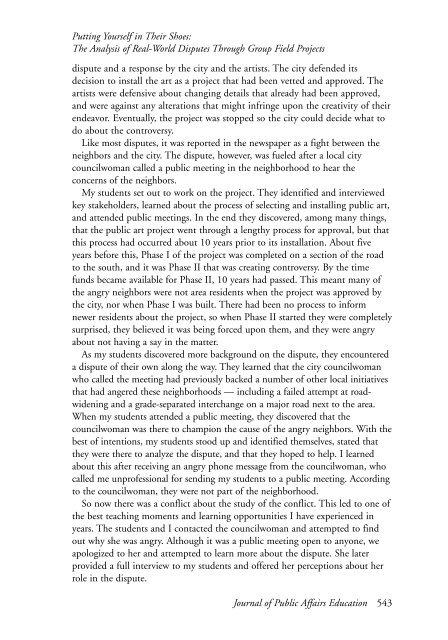JOURNAL OF PUBLIC AFFAIRS EDUCATION - National ...
JOURNAL OF PUBLIC AFFAIRS EDUCATION - National ...
JOURNAL OF PUBLIC AFFAIRS EDUCATION - National ...
You also want an ePaper? Increase the reach of your titles
YUMPU automatically turns print PDFs into web optimized ePapers that Google loves.
Putting Yourself in Their Shoes:<br />
The Analysis of Real-World Disputes Through Group Field Projects<br />
dispute and a response by the city and the artists. The city defended its<br />
decision to install the art as a project that had been vetted and approved. The<br />
artists were defensive about changing details that already had been approved,<br />
and were against any alterations that might infringe upon the creativity of their<br />
endeavor. Eventually, the project was stopped so the city could decide what to<br />
do about the controversy.<br />
Like most disputes, it was reported in the newspaper as a fight between the<br />
neighbors and the city. The dispute, however, was fueled after a local city<br />
councilwoman called a public meeting in the neighborhood to hear the<br />
concerns of the neighbors.<br />
My students set out to work on the project. They identified and interviewed<br />
key stakeholders, learned about the process of selecting and installing public art,<br />
and attended public meetings. In the end they discovered, among many things,<br />
that the public art project went through a lengthy process for approval, but that<br />
this process had occurred about 10 years prior to its installation. About five<br />
years before this, Phase I of the project was completed on a section of the road<br />
to the south, and it was Phase II that was creating controversy. By the time<br />
funds became available for Phase II, 10 years had passed. This meant many of<br />
the angry neighbors were not area residents when the project was approved by<br />
the city, nor when Phase I was built. There had been no process to inform<br />
newer residents about the project, so when Phase II started they were completely<br />
surprised, they believed it was being forced upon them, and they were angry<br />
about not having a say in the matter.<br />
As my students discovered more background on the dispute, they encountered<br />
a dispute of their own along the way. They learned that the city councilwoman<br />
who called the meeting had previously backed a number of other local initiatives<br />
that had angered these neighborhoods — including a failed attempt at roadwidening<br />
and a grade-separated interchange on a major road next to the area.<br />
When my students attended a public meeting, they discovered that the<br />
councilwoman was there to champion the cause of the angry neighbors. With the<br />
best of intentions, my students stood up and identified themselves, stated that<br />
they were there to analyze the dispute, and that they hoped to help. I learned<br />
about this after receiving an angry phone message from the councilwoman, who<br />
called me unprofessional for sending my students to a public meeting. According<br />
to the councilwoman, they were not part of the neighborhood.<br />
So now there was a conflict about the study of the conflict. This led to one of<br />
the best teaching moments and learning opportunities I have experienced in<br />
years. The students and I contacted the councilwoman and attempted to find<br />
out why she was angry. Although it was a public meeting open to anyone, we<br />
apologized to her and attempted to learn more about the dispute. She later<br />
provided a full interview to my students and offered her perceptions about her<br />
role in the dispute.<br />
Journal of Public Affairs Education 543

















